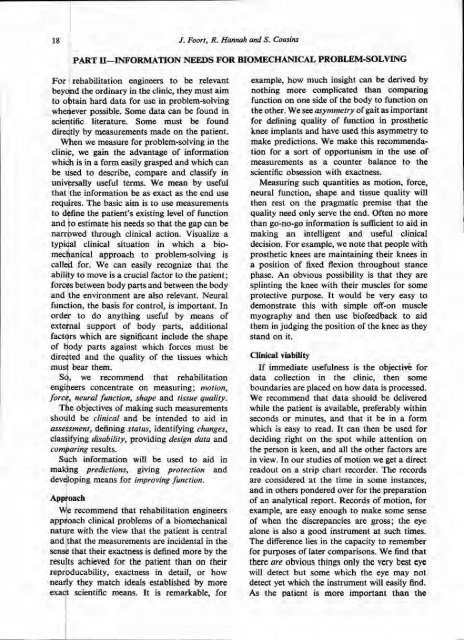Prosthetics and Orthotics
Prosthetics and Orthotics
Prosthetics and Orthotics
You also want an ePaper? Increase the reach of your titles
YUMPU automatically turns print PDFs into web optimized ePapers that Google loves.
PART II—INFORMATION NEEDS FOR BIOMECHANICAL PROBLEM-SOLVING<br />
For rehabilitation engineers to be relevant<br />
beyond the ordinary in the clinic, they must aim<br />
to obtain hard data for use in problem-solving<br />
whenever possible. Some data can be found in<br />
scientific literature. Some must be found<br />
directly by measurements made on the patient.<br />
When we measure for problem-solving in the<br />
clinic, we gain the advantage of information<br />
which is in a form easily grasped <strong>and</strong> which can<br />
be used to describe, compare <strong>and</strong> classify in<br />
universally useful terms. We mean by useful<br />
that the information be as exact as the end use<br />
requjres. The basic aim is to use measurements<br />
to define the patient's existing level of function<br />
<strong>and</strong> to estimate his needs so that the gap can be<br />
narrowed through clinical action. Visualize a<br />
typical clinical situation in which a biomechanical<br />
approach to problem-solving is<br />
called for. We can easily recognize that the<br />
ability to move is a crucial factor to the patient;<br />
forces between body parts <strong>and</strong> between the body<br />
<strong>and</strong> the environment are also relevant. Neural<br />
function, the basis for control, is important. In<br />
order to do anything useful by means of<br />
external support of body parts, additional<br />
factors which are significant include the shape<br />
of body parts against which forces must be<br />
directed <strong>and</strong> the quality of the tissues which<br />
must bear them.<br />
So, we recommend that rehabilitation<br />
engineers concentrate on measuring; motion,<br />
force, neural function, shape <strong>and</strong> tissue quality.<br />
The objectives of making such measurements<br />
should be clinical <strong>and</strong> be intended to aid in<br />
assessment, defining status, identifying changes,<br />
classifying disability, providing design data <strong>and</strong><br />
comparing results.<br />
Such information will be used to aid in<br />
making predictions, giving protection <strong>and</strong><br />
developing means for improving function.<br />
Approach<br />
We recommend that rehabilitation engineers<br />
approach clinical problems of a biomechanical<br />
nature with the view that the patient is central<br />
<strong>and</strong> that the measurements are incidental in the<br />
sense that their exactness is defined more by the<br />
results achieved for the patient than on their<br />
reprpducability, exactness in detail, or how<br />
nearly they match ideals established by more<br />
exact scientific means. It is remarkable, for<br />
example, how much insight can be derived by<br />
nothing more complicated than comparing<br />
function on one side of the body to function on<br />
the other. We see asymmetry of gait as important<br />
for defining quality of function in prosthetic<br />
knee implants <strong>and</strong> have used this asymmetry to<br />
make predictions. We make this recommendation<br />
for a sort of opportunism in the use of<br />
measurements as a counter balance to the<br />
scientific obsession with exactness.<br />
Measuring such quantities as motion, force,<br />
neural function, shape <strong>and</strong> tissue quality will<br />
then rest on the pragmatic premise that the<br />
quality need only serve the end. Often no more<br />
than go-no-go information is sufficient to aid in<br />
making an intelligent <strong>and</strong> useful clinical<br />
decision. For example, we note that people with<br />
prosthetic knees are maintaining their knees in<br />
a position of fixed flexion throughout stance<br />
phase. An obvious possibility is that they are<br />
splinting the knee with their muscles for some<br />
protective purpose. It would be very easy to<br />
demonstrate this with simple off-on muscle<br />
myography <strong>and</strong> then use biofeedback to aid<br />
them in judging the position of the knee as they<br />
st<strong>and</strong> on it.<br />
Clinical viability<br />
If immediate usefulness is the objective for<br />
data collection in the clinic, then some<br />
boundaries are placed on how data is processed.<br />
We recommend that data should be delivered<br />
while the patient is available, preferably within<br />
seconds or minutes, <strong>and</strong> that it be in a form<br />
which is easy to read. It can then be used for<br />
deciding right on the spot while attention on<br />
the person is keen, <strong>and</strong> all the other factors are<br />
in view. In our studies of motion we get a direct<br />
readout on a strip chart recorder. The records<br />
are considered at the time in some instances,<br />
<strong>and</strong> in others pondered over for the preparation<br />
of an analytical report. Records of motion, for<br />
example, are easy enough to make some sense<br />
of when the discrepancies are gross; the eye<br />
alone is also a good instrument at such times.<br />
The difference lies in the capacity to remember<br />
for purposes of later comparisons. We find that<br />
there are obvious things only the very best eye<br />
will detect but some which the eye may not<br />
detect yet which the instrument will easily find.<br />
As the patient is more important than the

















